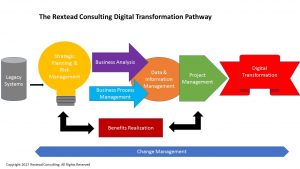
High Level Outcomes for a Digital Transformation
By Marc Edwards, B.Sc. , PMP, Content Analyticss, bpms, MBA
In my last post, I talked about the thought behind visioning for a business or digital transformation. Part of that process involves determining outcomes; those results that you are hoping for once you’ve done your transformation. In this post, we’ll take a look at some digital transformation outcomes that touch on internal processes, data, and customer satisfaction.
Increased Efficiencies by Decreasing Duplication and Increasing Automation
Every organization that undergoes digital transformation is looking to increase their internal efficiencies through decreased duplication and increased automation of their processes. When undergoing your digital transformation, some outcomes to look for are:
- Decreasing administrative time using multiple systems, data input and entry;
- Increasing the efficiency of your sites from an end to end customer experience;
- Eliminating paper records;
- Linking to other systems along the value chain;
- Adapting quickly as customer/ministry/program requirements change;
- Eliminating double work in office processes through an online scheduling system;
- Implementing an efficient online booking system for customers and partners to use for appointments and cancellations
Increased Focus on Data Management and Reporting
Digital transformation brings with it data…lots of data. So much data, you’ll quickly realize that your organization is changing from one driven by paper and manual processes into one driven by data. To take advantage of this, here are some outcomes you should strive for:
- To be able to run reports/obtain necessary data from one system to inform program decisions and customer services;
- To gather correct and complete information for program planning, delivery, evaluation, budget, ministry reporting, etc.;
- To increase access to customer data by staff regardless of location while being respectful of privacy and confidentiality;
- To improve customer care and outcomes due to staff who have greater access to data and information
Increased Customer Satisfaction
Last, but not least, is increasing customer satisfaction. This should be the holy grail of your digital transformation. To sip from that grail, consider attaining the following outcomes:
- Improving customer satisfaction through integrated services;
- Using current technology at all sites to create a seamless customer experience;
- Increasing customer and staff satisfaction in your organization’s services;
- Enhancing the customer’s experience;
- Enhancing your staff’s experience
Some Concluding Thoughts About High Level Outcomes for Digital Transformation
In summary, there are certain outcomes that you should consider when planning a business or digital transformation:
- To improve the overall user experience;
- To better inform decision making through electronic reporting;
- To improve clinical efficiencies through the elimination of duplicate and manual processes, and;
- To improve integration
By no means is this list comprehensive but it should give you a start in thinking about how to approach your digital transformation. If you have any questions about this, please email me at marc@rexteadconsultingcom or contact me at http://rexteadconsulting.com/contact/.










